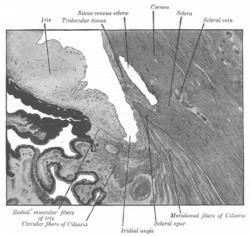Trabecular meshwork of the eye
| Trabecular meshwork | |
|---|---|

Enlarged general view of the iridial angle. (When enlarged, visible with older label of 'trabecular tissue')
|
|
| Details | |
| Identifiers | |
| Latin | reticulum trabeculare sclerae |
| MeSH | A09.371.060.932 |
| Dorlands /Elsevier |
r_10/12705894 |
|
Anatomical terminology
[]
|
|
The trabecular meshwork is an area of tissue in the eye located around the base of the cornea, near the ciliary body, and is responsible for draining the aqueous humor from the eye via the anterior chamber (the chamber on the front of the eye covered by the cornea).
The tissue is spongy and lined by trabeculocytes; it allows fluid to drain into a set of tubes called Schlemm's canal flowing into the blood system.
The meshwork is divided up into three parts, with characteristically different ultrastructures:
The trabecular meshwork is assisted to a small degree in the drainage of aqueous humour by a second outflow pathway, the uveo-scleral pathway (5-10% of outflow occurs this way). The uveo-scleral pathway is increased with the use of glaucoma drugs such as prostaglandins (e.g., Xalatan, Travatan).
The trabecular meshwork had previously been thought to arise from a point (apex) corresponding to the termination of the DM (Schwalbe’s line) however it is now considered to extend into the cornea, forming the Dua's layer.
It is thought that most cases of glaucoma (although not all) are caused or enabled by an increase in intraocular pressure. Pressure increases either when too much aqueous humor fluid is produced or by decreased aqueous humor outflow. The trabecular meshwork is responsible for most of the outflow of aqueous humor. When outflow is blocked, interventions such as trabeculectomy, trabeculoplasty, or aqueous shunt may be required to restore it.
...
Wikipedia
